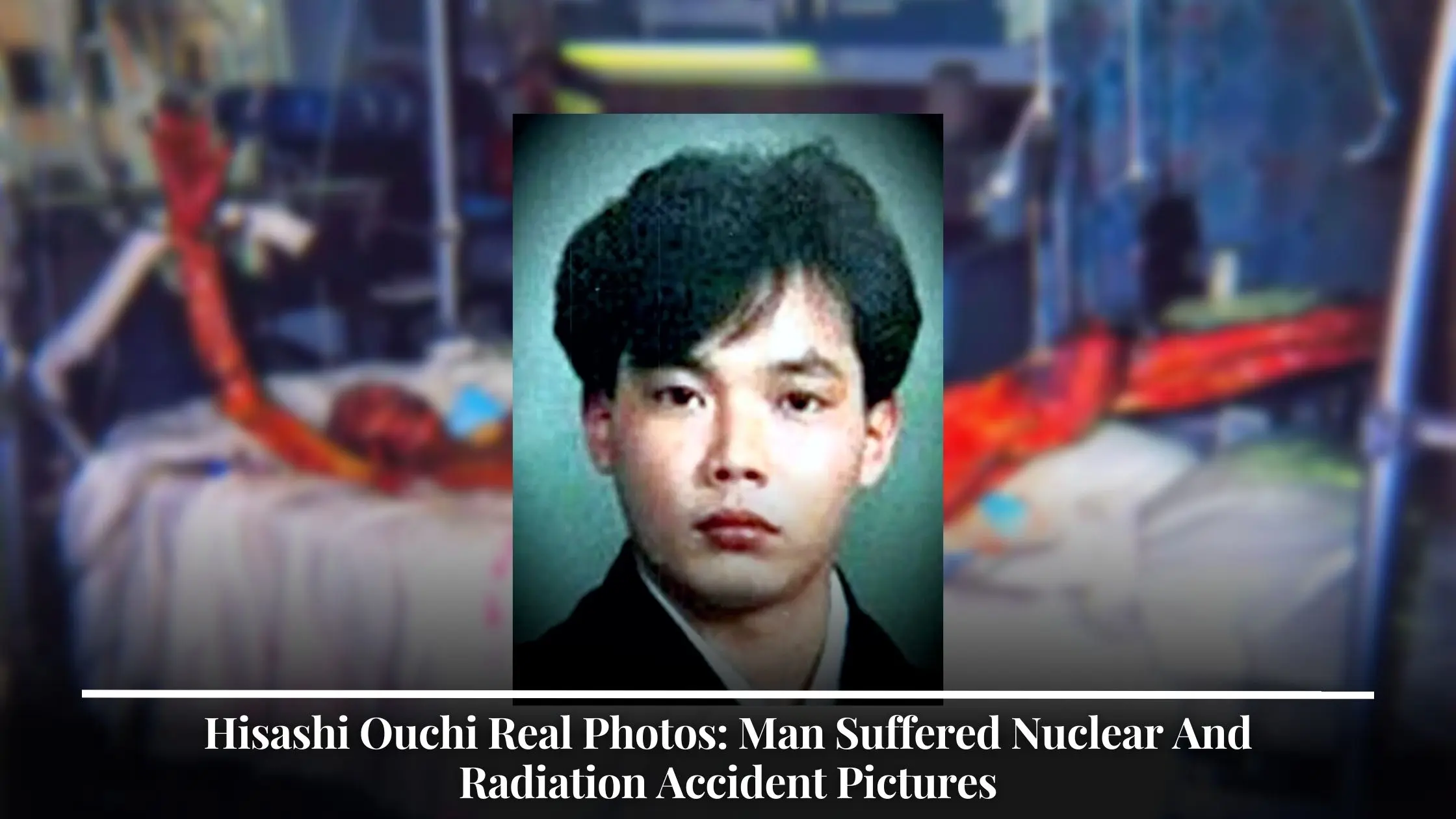Hisashi Ouchi Radiation Fotos: The Untold Story Behind The Iconic Images
Hisashi Ouchi's story is a tragic reminder of the dangers of radiation exposure, and the photographs that captured his final days have become some of the most haunting images in history. But what do we really know about these photos? Who was Hisashi Ouchi, and why do these images continue to resonate so deeply? Let's dive into the story behind the man and the unforgettable pictures that changed how we view radiation exposure.
When you first hear about Hisashi Ouchi, the images that come to mind are often those shocking photographs that have circulated online. But there's so much more to his story than just the pictures. Hisashi wasn't just a victim of radiation; he was a human being with a life, dreams, and a family who suffered unimaginably due to an accident that could have been avoided.
This article will explore the details of Hisashi Ouchi's life, the circumstances surrounding the radiation accident, and the significance of the photographs that made headlines around the world. By understanding the full context, we can honor Hisashi's memory and ensure that lessons are learned from this tragedy.
Who Was Hisashi Ouchi? A Brief Biography
Before we dive into the radiation incident and the infamous fotos, let's take a moment to understand who Hisashi Ouchi was as a person. Born in Japan, Hisashi worked at the Tokaimura nuclear facility, where he became involved in one of the worst radiation accidents in history. Below is a quick overview of Hisashi's life:
| Name | Hisashi Ouchi |
|---|---|
| Birth Date | March 26, 1968 |
| Occupation | Worker at the JCO nuclear processing facility |
| Date of Accident | September 30, 1999 |
| Place of Accident | Tokaimura, Japan |
| Cause of Death | Acute radiation sickness |
Hisashi was a dedicated worker who, unfortunately, became a symbol of the dangers of nuclear power due to the tragic accident that claimed his life. His story is one of courage and suffering, and it’s crucial to remember him as more than just a statistic or a photo.
The Tokaimura Accident: What Happened?
The Tokaimura nuclear accident occurred on September 30, 1999, at the JCO nuclear processing facility in Tokaimura, Japan. It was caused by a criticality accident, which happens when a nuclear chain reaction becomes uncontrolled. This incident exposed Hisashi Ouchi and two of his colleagues to lethal doses of radiation.
- Discover The Vibrant World Of Beer City Music Hall
- Understanding The Role Of The Alabama Real Estate Commission
What makes this accident so significant is that it was entirely preventable. The workers were mixing uranium in a precipitation tank, but they exceeded the safe limits for uranium enrichment. This led to a criticality event, releasing a burst of neutron radiation and gamma rays. Hisashi Ouchi was the closest to the tank and absorbed a massive dose of radiation—around 17 sieverts, which is far above the lethal limit.
How Did the Accident Happen?
Here’s a quick breakdown of the events leading up to the disaster:
- Human Error: The workers manually mixed uranium in a stainless-steel bucket instead of using automated equipment, violating safety protocols.
- Improper Training: The staff at the facility lacked proper training in nuclear safety procedures.
- Regulatory Oversight: Insufficient regulatory oversight allowed unsafe practices to continue unchecked.
These factors combined to create a perfect storm, resulting in one of the deadliest radiation accidents in history. Hisashi Ouchi paid the ultimate price for these mistakes, and his case serves as a stark reminder of the importance of safety in nuclear facilities.
Hisashi Ouchi Radiation Fotos: The Story Behind the Pictures
The photographs of Hisashi Ouchi have become some of the most iconic images of radiation exposure. But what exactly do these fotos show, and why are they so unsettling? Let’s explore the details.
The images depict Hisashi in the hospital, showing the devastating effects of acute radiation sickness. His skin appears burned and blistered, and his body is visibly weakened by the massive dose of radiation he absorbed. These fotos were taken during his 83-day hospitalization, during which he endured unimaginable pain.
Why Are These Fotos So Haunting?
There are several reasons why these fotos have such a lasting impact:
- Human Suffering: The fotos vividly illustrate the physical toll of radiation exposure, making it difficult to look away.
- Symbol of Danger: They serve as a powerful reminder of the dangers of nuclear energy and the importance of safety protocols.
- Emotional Connection: Seeing someone suffer so visibly creates an emotional connection that no statistic or report can replicate.
While these fotos are undeniably disturbing, they also play an important role in raising awareness about the risks of nuclear accidents and the need for better safety measures.
Understanding Radiation Exposure
To fully grasp the significance of Hisashi Ouchi’s story, it’s essential to understand what radiation exposure entails. Radiation is a form of energy that can penetrate living tissue, causing cellular damage. When someone is exposed to high levels of radiation, it can lead to acute radiation sickness, which includes symptoms like burns, nausea, and internal organ failure.
Hisashi Ouchi absorbed a staggering 17 sieverts of radiation, which is well above the lethal dose of 5 sieverts. This exposure caused extensive damage to his body, including:
- Burns and blisters on his skin
- Internal organ failure
- Severe blood loss and anemia
Despite receiving the best medical care available, Hisashi’s body could not recover from the damage, and he eventually passed away after 83 days of suffering.
The Aftermath: Lessons Learned
In the wake of the Tokaimura accident, significant changes were made to improve nuclear safety worldwide. Regulatory bodies tightened their oversight, and new protocols were implemented to prevent similar incidents from occurring in the future. However, the lessons of Hisashi Ouchi’s tragedy continue to resonate today.
Key Takeaways from the Incident
Here are some of the most important lessons learned from the Tokaimura accident:
- Strict Safety Protocols: Nuclear facilities must adhere to strict safety standards to prevent criticality accidents.
- Comprehensive Training: Workers must receive thorough training in nuclear safety procedures to avoid human error.
- Accountability: Companies and regulators must be held accountable for ensuring safe practices in nuclear facilities.
These lessons have helped improve safety standards in the nuclear industry, but vigilance is still crucial to prevent future accidents.
The Impact on Public Perception
The photographs of Hisashi Ouchi had a profound impact on public perception of nuclear energy. They highlighted the dangers of radiation exposure and sparked debates about the safety and ethics of nuclear power. Many people began questioning whether the risks outweighed the benefits, leading to increased scrutiny of nuclear facilities worldwide.
While nuclear energy remains a controversial topic, the images of Hisashi Ouchi continue to serve as a powerful reminder of the potential consequences of nuclear accidents. They have also influenced policy decisions and public opinion, contributing to a more cautious approach to nuclear energy development.
Hisashi Ouchi’s Legacy
Hisashi Ouchi’s legacy extends far beyond the photographs that made him famous. His story serves as a cautionary tale about the dangers of radiation exposure and the importance of safety in nuclear facilities. By remembering Hisashi’s suffering, we can work toward a safer future for everyone.
How Can We Honor Hisashi’s Memory?
Here are a few ways to honor Hisashi Ouchi’s memory and ensure that his story continues to inspire change:
- Advocate for improved safety standards in nuclear facilities.
- Support organizations working to promote nuclear safety and awareness.
- Remember Hisashi as a person, not just as a symbol of tragedy.
By taking these actions, we can ensure that Hisashi’s legacy lives on and that his suffering was not in vain.
Conclusion: Remembering Hisashi Ouchi
In conclusion, Hisashi Ouchi’s story is one of courage, suffering, and resilience. The photographs of his final days may be difficult to look at, but they serve as a powerful reminder of the dangers of radiation exposure and the importance of nuclear safety. By understanding the full context of Hisashi’s tragedy, we can honor his memory and work toward a safer future.
So, what can you do next? Share this article with others to spread awareness about the dangers of radiation exposure. Leave a comment below sharing your thoughts on Hisashi Ouchi’s story. And most importantly, remember Hisashi as more than just a statistic or a photo—remember him as a human being whose life and suffering have taught us invaluable lessons.
Table of Contents
- Who Was Hisashi Ouchi? A Brief Biography
- The Tokaimura Accident: What Happened?
- Hisashi Ouchi Radiation Fotos: The Story Behind the Pictures
- Understanding Radiation Exposure
- The Aftermath: Lessons Learned
- The Impact on Public Perception
- Hisashi Ouchi’s Legacy
- Conclusion: Remembering Hisashi Ouchi
- Discover The Ultimate Seafood Dining Experience At Legal Seafood Harborside
- Experience The Best Of Atlanta At Hilton Garden Inn Midtown

Hisashi Ouchi The Horrific Story Of The Man Who Endured 83 Days Of

Unveiled The Harrowing Reality Of Hisashi Ouchi's RadiationInduced

Unveiled The Harrowing Reality Of Hisashi Ouchi's RadiationInduced